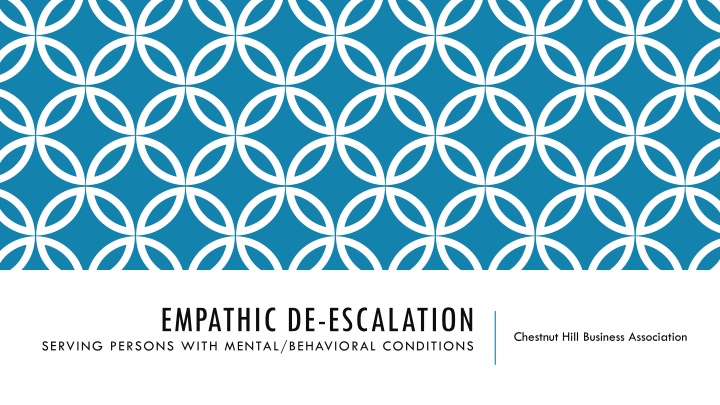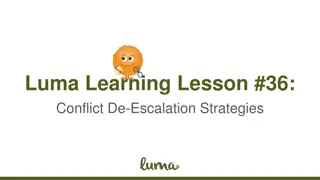Empathic De-escalation for Handling Mental Health Issues in the Workplace
Reduce stigma around mental and behavioral health in the workplace through education. Understand behaviors as forms of communication and learn de-escalation techniques. Manage responses, establish rapport, and use non-judgmental approaches to address escalating situations effectively.
Uploaded on Oct 02, 2024 | 2 Views
Download Presentation

Please find below an Image/Link to download the presentation.
The content on the website is provided AS IS for your information and personal use only. It may not be sold, licensed, or shared on other websites without obtaining consent from the author.If you encounter any issues during the download, it is possible that the publisher has removed the file from their server.
You are allowed to download the files provided on this website for personal or commercial use, subject to the condition that they are used lawfully. All files are the property of their respective owners.
The content on the website is provided AS IS for your information and personal use only. It may not be sold, licensed, or shared on other websites without obtaining consent from the author.
E N D
Presentation Transcript
EMPATHIC DE-ESCALATION SERVING PERSONS WITH MENTAL/BEHAVIORAL CONDITIONS Chestnut Hill Business Association
OBJECTIVES Decrease stigma of mental/behavioral health by providing education to local business community on how to handle mental health issues in the work place. Understand behavior escalation. Learn ways to de-escalate a situations when interacting with a person with Mental/Behavioral Health issues.
All behavior is a form of communication, and escalating behavior is the communication of increasing distress.What if, instead of seeing a person as challenging, you view them as a person in distress? Think of their words and actions as the communication of that distress.Fear and anxiety play a large role in a person s escalating behaviors. It s important to consider the reasons why a person s behavior may escalate (CPI, 2020) INTRODUCTION
WHAT CAN I DO TO DECREASE CHANCES OF BEHAVIOR ESCALATING? Mange your response, what you say and do can control the outcome of the interaction. Do your best to act as a helper by assisting them in locating the item or service that they need. Establish a rapport with them, you can ask them their name and introduce yourself. Note: If the person is delusional, avoid trying to correct their hallucinations, this may cause her or him to become agitated. Try bringing their attention back to the product or service in question. If possible, avoid drawing attention to someone who is displaying signs of a mental health condition as it may make matters worse
UNDERSTANDING BEHAVIOR ESCALATION Customer Merchant Response Body language Body language, relaxed, hands in view.. Tone & volume of voice Tone & volume of voice Level of escalation Anxiety: Tense posture, Pacing, etc Defensive: Screaming, etc Risk Behavior: Throwing things, physical Empathic, non-judgmental Directive Safety precaution
Personal Space (protective barrier) WHAT IF Team Approach Do not argue, threaten, or try to rationalize BEHAVIORS ARE ESCALATING?
BREATHING THROUGH IT Mindfulness Calming breathe Phone a friend
RESOURCES https://dbhids.org/community/public-education-training/healthy-minds- philly/mental-health-first-aid-mhfa/ https://www.youtube.com/watch?v=DoS4FbjuOj8 https://healthymindsphilly.org/mhfa/ https://youtu.be/rkZl2gsLUp4
REFERENCE Crisis Prevention Institute (U.S.). (2020). CPI Nonviolent crisis intervention training 2nd edition. Brookfield, WI: The Institute.























